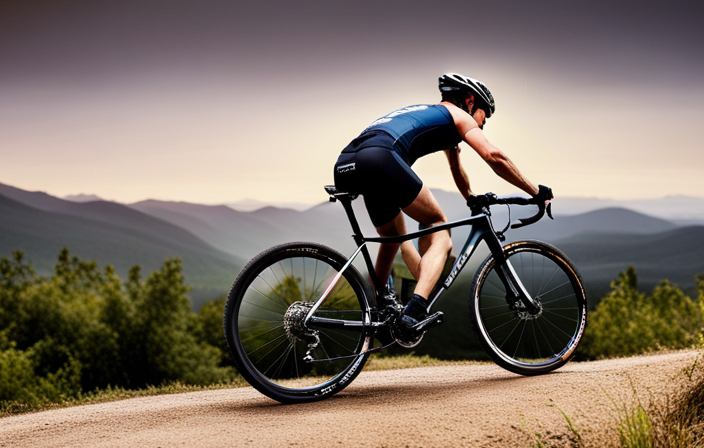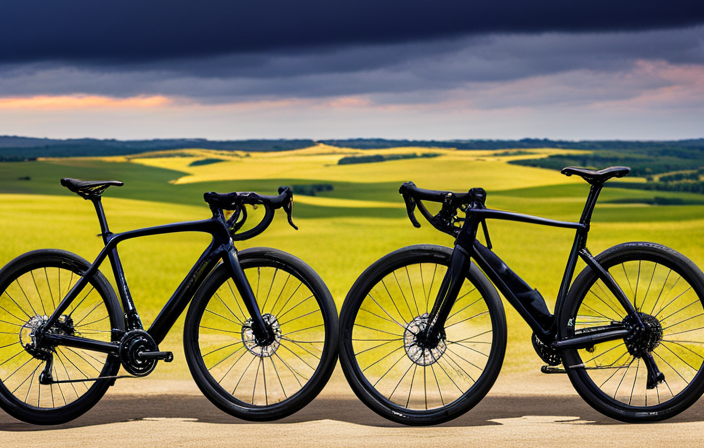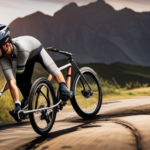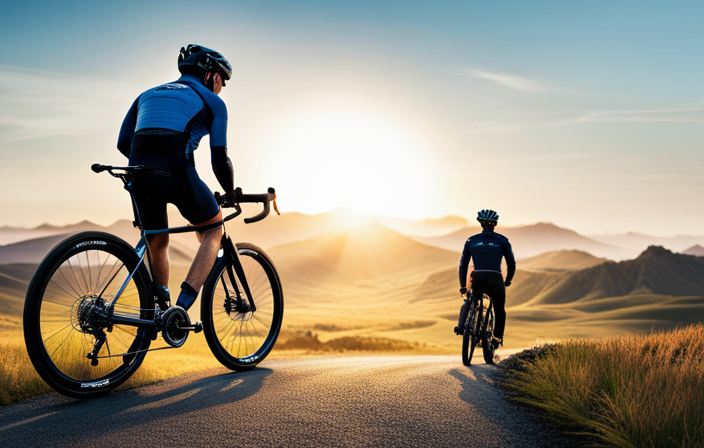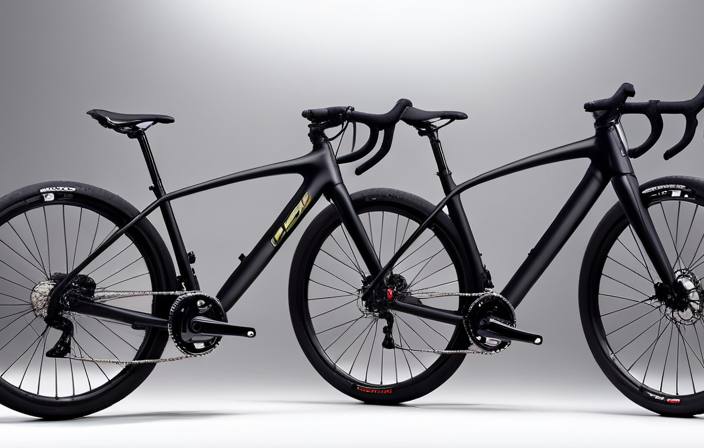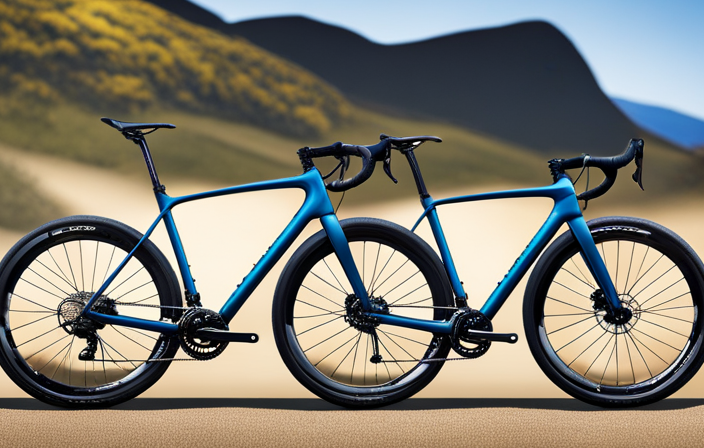As an avid cyclist, I have found that exploring rough terrains on a mountain bike can be a thrilling and demanding adventure. It takes skill, technique, and the proper equipment to navigate gravel paths successfully.
In this article, I will share my knowledge and passion for gravel riding, providing you with valuable tips on choosing the right bike, preparing for the trails, mastering weight distribution, and more.
Get ready to embrace the thrill of gravel riding as we dive into this exciting adventure together.
Key Takeaways
- Choosing the right bike for gravel riding
- Preparing your bike for gravel trails
- Mastering the technique of weight distribution
- Tips for riding on rough terrain
Choose the Right Bike for Gravel Riding
To ride a mountain bike on gravel, you’ll need to choose the right bike for this type of terrain. When it comes to gravel riding, having the appropriate bike can make all the difference in your experience. A bike that is specifically designed for off-road trails and has wider tires with more grip will give you better control and stability on loose surfaces. Additionally, look for a bike that has sturdy construction and good suspension to absorb the bumps and vibrations commonly found on gravel trails.
When it comes to bike maintenance, regularly cleaning and lubricating your chain is essential for smooth shifting and efficient pedaling. Gravel can be particularly abrasive, so inspecting your tires frequently for any signs of wear or damage is crucial. It’s also important to carry a basic repair kit with you when riding on gravel trails, as punctures are more likely to occur.
In terms of gravel riding tips, remember to always maintain a relaxed grip on the handlebars and keep your body loose while riding over rough terrain. Look ahead at least 10-15 feet in order to anticipate any obstacles or changes in terrain. And finally, don’t forget to adjust your tire pressure accordingly – lower pressure offers better traction on loose surfaces.
Now that you have chosen the right bike for gravel riding, let’s move onto preparing your bike for those challenging trails.
Prepare Your Bike for Gravel Trails
Before hitting the trails, make sure your bicycle is ready for riding on uneven surfaces. Bike maintenance is key when it comes to preparing your bike for gravel trails. Start by giving your bike a thorough inspection – check the brakes, gears, and chain to ensure they are in good working condition. Make any necessary adjustments or repairs before heading out.
One of the most important aspects of preparing your bike for gravel riding is choosing the right tires. Gravel trails can be rough and unpredictable, so having the appropriate tires can greatly enhance your riding experience. Look for tires with a wider width and a tread pattern that offers good traction on loose surfaces. This will provide stability and control as you navigate through different terrains.
I’ve found that having tubeless tires can also be beneficial when riding on gravel. They offer better puncture resistance and allow you to run lower tire pressures without worrying about pinch flats. This can result in improved comfort and grip while riding over uneven surfaces.
Properly maintaining your bike and selecting the right tires are crucial steps in getting ready for gravel trails. Once you have everything set up, it’s time to think about wearing the proper safety gear…
Wear the Proper Safety Gear
Make sure you’re wearing the right safety gear for your adventure on rough terrain. When riding a mountain bike on gravel, it’s essential to prioritize your safety by donning the proper equipment. By doing so, you can maximize protection and minimize the risk of injuries.
To ensure you have the necessary gear, refer to the table below:
| Safety Gear | Purpose |
|---|---|
| Helmet | Protects your head from potential impacts |
| Knee pads | Guards against scrapes and bruises |
| Elbow pads | Provides additional protection for joints |
| Gloves | Offers better grip and protects hands |
Wearing these items will not only keep you safe but also enhance your overall biking experience. As an experienced rider, I can attest to the importance of investing in high-quality safety gear. It allows me to push my limits without compromising my well-being.
Now that we’ve covered the importance of wearing proper safety gear, let’s move on to mastering the technique of weight distribution when riding a mountain bike on gravel trails. This skill is crucial for maintaining balance and control throughout your ride.
Master the Technique of Weight Distribution
Mastering the technique of weight distribution is essential for maintaining balance and control while riding on rough terrain. When riding a mountain bike on gravel, it becomes even more crucial to understand how to distribute your weight effectively. Here are some weight distribution tips that will help you conquer those challenging trails:
-
Keep your body centered: By keeping your body centered over the bike, you’ll have better control and be able to react quickly to changes in terrain.
-
Bend your elbows and knees: This helps absorb vibrations and impacts, allowing the bike to move beneath you without throwing you off balance.
-
Lean into turns: As you approach a turn on gravel, shift your weight towards the inside of the turn. This will provide extra traction and stability.
-
Shift your weight back during descents: When going downhill, move your body slightly behind the saddle. This puts more weight on the rear wheel, improving traction and preventing potential accidents.
Proper body positioning plays a vital role in navigating gravel terrain safely. Once you have mastered weight distribution, it’s time to adjust your riding position for this specific type of surface.
Adjust Your Riding Position for Gravel Terrain
Once you’ve got the hang of distributing your weight, it’s time to adjust your riding position for rough gravel terrain. Mastering bike control and improving cornering skills are crucial when tackling this challenging surface.
When riding on gravel, I like to slightly shift my body weight towards the back of the bike. This helps maintain stability and prevents the front wheel from washing out. Keeping a relaxed grip on the handlebars allows me to quickly react to any unexpected changes in terrain.
To navigate corners on gravel, I find that leaning my body into the turn while keeping my outside foot down helps maintain traction and control. It’s important to look ahead and anticipate any loose patches or obstacles in order to adjust my line accordingly. By properly adjusting my riding position for gravel terrain, I am able to confidently maneuver through tight corners with ease.
Transition: Now that we have covered adjusting your riding position for gravel terrain, let’s move on to maintaining a steady and balanced speed without compromising control.
Maintain a Steady and Balanced Speed
To maintain a steady and balanced speed on rough terrain, you should focus on keeping your body relaxed and your eyes focused ahead. Riding a mountain bike on gravel can be challenging, but with the right techniques, you can conquer any trail.
Here are three key tips to help you master cornering techniques and maintain momentum:
-
Lean into the turns: When approaching a corner, shift your weight slightly towards the inside of the turn. This will help you maintain traction and control throughout the maneuver.
-
Look where you want to go: Keep your eyes focused ahead on the path you want to take. By looking where you want to go instead of at obstacles or hazards, you’ll naturally steer in the right direction and stay on track.
-
Use your brakes wisely: While it’s tempting to slam on the brakes when things get rough, try using gentle braking instead. Feathering your brakes will allow you to maintain momentum while still staying in control.
By mastering these cornering techniques and maintaining momentum, you’ll be able to navigate gravel terrain smoothly and confidently.
Next, we’ll discuss how using the correct braking technique can further enhance your ride without compromising safety.
Use the Correct Braking Technique
Using the correct braking technique is crucial for maintaining control and safety on rough terrain. When it comes to mountain biking on gravel, understanding the different braking techniques for various terrains is essential. Gravel can be unpredictable, with loose stones and uneven surfaces that can easily cause you to lose traction. To navigate these challenges effectively, it’s important to know how to brake correctly.
On loose gravel, applying the brakes too abruptly can cause your wheels to lock up and skid. This not only reduces your ability to steer but also increases the risk of losing control altogether. Instead, try using a combination of front and rear brakes while gradually decreasing pressure. By doing this, you’ll maintain better traction and stability as you slow down.
Another important technique is modulating your braking power when going downhill on gravel. As gravity pulls you forward, it’s crucial to have precise control over your speed without compromising stability. Feathering the brakes by lightly squeezing them at regular intervals allows you to maintain momentum while keeping a steady pace.
Mastering proper braking technique plays a vital role in mountain biking on gravel. It not only enhances your ability to maneuver challenging terrains but also ensures a safer riding experience overall. With consistent practice and attention to detail, you’ll gain confidence in controlling your bike’s speed effectively.
Now that we’ve covered the importance of proper braking techniques let’s move on to learning how to navigate loose gravel without compromising balance and stability.
Learn to Navigate Loose Gravel
Navigating loose gravel can be challenging, but with the right technique, it becomes easier to maintain balance and stability. Learning to control your bike on loose gravel is crucial for a smooth ride.
Here are four helpful tips to adapt your riding style to different gravel conditions:
-
Relax your grip: It’s natural to feel tense when riding on unstable terrain, but gripping the handlebars too tightly can actually hinder your control. Loosen up and let your bike flow beneath you.
-
Keep a steady cadence: Maintaining a consistent pedaling rhythm helps you power through the gravel without losing traction. Avoid sudden bursts of speed or harsh braking that could cause skidding.
-
Choose the best line: Gravel can vary in size and shape, so it’s important to find the smoothest path. Look ahead and anticipate where there might be deeper patches or loose rocks, then steer around them.
-
Feather your brakes: Instead of grabbing the brakes forcefully, lightly apply pressure intermittently to slow down gradually while maintaining traction.
By mastering these techniques, you’ll gain confidence and control over loose gravel surfaces.
Now let’s transition into how to handle corners and turns with confidence without missing a beat!
Handle Corners and Turns with Confidence
Mastering the techniques for handling corners and turns with confidence will greatly enhance your riding experience on loose gravel surfaces. When it comes to riding a mountain bike on gravel, improving your cornering technique is crucial. It allows you to maintain control, navigate through turns smoothly, and handle gravel descents with ease.
To handle corners effectively on gravel, there are a few key principles to keep in mind. Firstly, approach the corner at an appropriate speed that allows you to stay in control while still maintaining momentum. As you enter the turn, shift your body weight towards the outside pedal and lean into the corner slightly. This helps to maintain traction and stability.
In addition to these principles, it’s important to use proper braking technique when approaching corners on loose gravel. Apply gentle pressure on both brakes evenly before entering the turn, gradually releasing as you exit. This helps prevent skidding and maintains control throughout the maneuver.
Table: Handling Corners and Turns
| Principle | Description |
|---|---|
| Appropriate Speed | Maintain control while keeping momentum |
| Body Positioning | Shift weight towards outside pedal and lean into the corner |
| Braking Technique | Apply even pressure on both brakes before turning |
By mastering these techniques, you’ll be able to confidently handle corners and turns on gravel trails. Now let’s move on to the next section about watching out for obstacles on the trail without losing our flow.
Watch Out for Obstacles on the Trail
Be mindful of any obstacles you may encounter on the trail to ensure a smooth and uninterrupted ride. As you navigate through gravel on your mountain bike, it is crucial to maintain obstacle awareness and be prepared for anything that might come your way. Here are some key points to keep in mind:
- Stay focused: Keep your eyes scanning ahead, looking for rocks, roots, or any other potential hazards.
- Adjust your speed: Slow down when approaching obstacles to give yourself enough time to react and maneuver around them safely.
- Use proper technique: Maintain a strong grip on the handlebars and shift your body weight as needed to maintain balance and control.
Choose the best line: Look for the path of least resistance when encountering obstacles. This may involve riding around or over them, depending on their size and shape.
- Be adaptable: Trail conditions can change rapidly, so stay flexible and adjust your strategy accordingly.
By staying aware of potential obstacles and navigating the trail with confidence, you’ll be able to enjoy a thrilling ride while minimizing any disruptions.
Transitioning into the next section about choosing the best line for optimal traction will further enhance your overall trail experience.
Choose the Best Line for Optimal Traction
To ensure optimal traction on the trail, you’ll want to carefully select the best line to navigate through any potential obstacles. Optimal line selection is crucial when riding a mountain bike on gravel, as it allows you to maintain control and grip on loose surfaces.
When approaching a corner, it’s important to choose a line that maximizes traction and minimizes the risk of sliding out. One technique for cornering on gravel is to take a wide entry into the turn, allowing you to carry more speed and maintain better control throughout the maneuver. As you enter the corner, shift your weight towards the outside pedal and lean your bike into the turn, keeping your eyes focused on where you want to go.
By following these cornering techniques and selecting the best line for each obstacle, you’ll be able to confidently ride smoothly and efficiently on gravel without compromising traction or control.
Now let’s move on to how we can ride smoothly and efficiently on gravel without sacrificing speed or stability.
Ride Smoothly and Efficiently on Gravel
Achieving a smooth and efficient ride on gravel requires finding the optimal line and maintaining control. When riding a mountain bike on gravel, mastering bike control is essential. It allows you to handle bumps and vibrations with ease, providing a more enjoyable experience overall.
To ride smoothly on gravel, you must anticipate the terrain ahead. Keep your body relaxed and flexible, allowing the bike to move underneath you while maintaining stability. This will help absorb the impact of bumps and vibrations, preventing them from throwing you off balance.
Maintaining a proper riding posture is also crucial for a smooth ride. Keep your weight centered over the bike by bending your elbows and knees slightly. This position improves traction and control, enabling you to maneuver through rough patches effortlessly.
Additionally, adjusting your speed can significantly impact how smoothly you ride on gravel. Slow down when approaching uneven surfaces or loose sections to maintain better traction and stability.
By mastering bike control and handling bumps and vibrations effectively, you’ll be well-equipped for navigating gravel trails with finesse.
As we move into the next section about practicing riding on various gravel surfaces, remember that these skills are foundational for building confidence in any terrain without compromising performance or enjoyment.
Practice Riding on Various Gravel Surfaces
When riding on different types of gravel surfaces, it’s important to adapt your technique and maintain control for a smoother experience.
Gravel bike trails can vary in terms of the type and size of gravel, as well as the level of compactness. To ride smoothly on loose gravel, it’s crucial to distribute your weight evenly between both tires and slightly lean back to keep traction. This helps prevent fishtailing or sliding out on the loose surface. Additionally, maintaining a relaxed grip on the handlebars allows for better control and absorbs some of the vibrations.
Techniques for handling loose gravel include using wider tires with lower pressure to increase stability and improve traction. It’s also helpful to choose an appropriate gear that allows you to pedal smoothly without spinning out or straining too much. As you encounter different types of gravel surfaces, such as larger rocks or softer dirt patches, adjust your body position accordingly by shifting your weight forward or backward.
By practicing riding on various gravel surfaces, you’ll become more comfortable and confident in adapting your technique. This will not only enhance your overall riding experience but also improve your ability to handle unexpected challenges along the way.
Transitioning into building endurance and strength for gravel riding, let’s explore how training can further enhance your skills on these diverse terrains without compromising performance.
Build Endurance and Strength for Gravel Riding
Building endurance and strength is essential for excelling in gravel riding. It’s not just about tackling the challenging terrain, but also about being able to ride longer distances with ease. To build muscle and increase stamina, I recommend incorporating a combination of cardiovascular exercises and strength training into your routine.
Cardiovascular exercises such as cycling, running, or swimming are great for improving overall endurance. Aim for at least three to four sessions per week, gradually increasing the intensity and duration over time. This will help you develop the cardiovascular fitness needed to handle long rides on gravel surfaces.
In addition to cardio, don’t forget about strength training. Focusing on your lower body muscles like quads, hamstrings, and glutes will give you the power needed to conquer those steep inclines on gravel trails. Incorporate exercises like squats, lunges, and deadlifts into your workout regimen.
Remember to listen to your body and allow for proper rest and recovery days. Pushing yourself too hard without adequate rest can lead to injuries and setbacks.
By building endurance and strength through a combination of cardio workouts and targeted strength training exercises, you’ll be ready to take on the challenges of gravel riding with confidence. So gear up, hit those trails, have fun, and enjoy the thrilling experience that gravel riding has to offer!
Have Fun and Enjoy the Thrill of Gravel Riding
To fully embrace the excitement of gravel riding, just let go and enjoy the thrilling experience of conquering new terrains. There’s something truly exhilarating about venturing off-road on a mountain bike and feeling the gravel beneath your tires.
Here are some tips to help you have fun and make the most of your gravel riding adventures:
-
Finding the best gravel riding routes: Explore local trail networks, ask fellow riders for recommendations, or use online platforms to discover popular gravel routes in your area. Researching beforehand ensures you’ll find picturesque landscapes and challenging paths that cater to your skill level.
-
Tips for improving your gravel riding skills: Practice bike handling techniques like cornering, braking, and descending on loose surfaces. It’s also important to choose suitable gear ratios for climbing steep gradients without burning out. Additionally, working on core strength and stability will enhance your overall performance on rough terrains.
-
Embrace unpredictability: Gravel riding can be unpredictable, with ever-changing surfaces and unexpected obstacles. Instead of fearing these challenges, embrace them as opportunities to improve your skills and resilience as a rider.
-
Connect with a community: Joining a local cycling group or participating in organized events can introduce you to like-minded individuals who share your passion for gravel riding. These connections provide valuable opportunities for learning from experienced riders while creating lasting memories.
By following these tips and approaching each ride with enthusiasm, you’ll not only enjoy the thrill of conquering new terrains but also become a more skilled and confident gravel rider. So hop on your mountain bike, explore those hidden routes, and let the adventure begin!
Frequently Asked Questions
How do I choose the right bike for gravel riding?
When it comes to bike selection for gravel riding, choosing the right one is crucial. It’s important to consider factors such as frame material, geometry, and components that suit your riding style.
Additionally, selecting the appropriate tires is key for a smooth and enjoyable ride on gravel surfaces. Opting for wider tires with a tread pattern designed for off-road conditions will provide better traction and stability.
So, make sure to do your research and find a bike that meets your specific gravel riding needs.
What safety gear should I wear when riding a mountain bike on gravel?
When riding a mountain bike on gravel, it’s crucial to prioritize safety. To protect myself, I always wear a helmet and gloves.
A good-quality helmet is essential for safeguarding my head in case of any accidents or falls. Additionally, gloves provide me with better grip and control while navigating the rough terrain.
These safety gears are non-negotiable and give me peace of mind during my thrilling rides on gravel trails.
How do I properly adjust my riding position for gravel terrain?
To properly adjust my riding position for gravel terrain, I focus on two key aspects: adjusting posture and maintaining balance.
When riding on gravel, I make sure to keep my weight centered over the bike and slightly shifted back to increase stability.
I also bend my elbows and knees slightly to absorb any bumps or vibrations. This helps me maintain control and maneuverability, allowing me to confidently tackle any gravel trail with ease.
What are some tips for navigating loose gravel?
Navigating loose gravel on a mountain bike requires finesse and skill. Like a tightrope walker, I carefully tread the line between avoiding skidding and maintaining balance.
My experienced hands gently steer the handlebars, while my body instinctively adjusts to the shifting terrain. It’s all about finding that delicate rhythm, flowing with the bike as it dances over the loose stones.
With practice and passion, conquering gravel becomes second nature, and every ride becomes an exhilarating adventure.
How can I build endurance and strength for gravel riding?
To build endurance and strength for gravel riding, I focus on two key aspects: building muscle and proper nutrition for endurance.
Building muscle involves a combination of strength training exercises such as squats, lunges, and deadlifts to target the major muscles used in biking.
As for nutrition, I ensure I consume a balanced diet that includes lean proteins, complex carbohydrates, and healthy fats to fuel my body during long rides.
By prioritizing these aspects, I have seen significant improvements in my performance on gravel trails.
Conclusion
As I reflect on my exhilarating journey of learning how to ride a mountain bike on gravel, I can’t help but feel a rush of excitement and satisfaction. The thrill of conquering challenging terrains, the adrenaline coursing through my veins as I navigate through loose gravel, it all adds up to an unforgettable experience.
But this is just the beginning. There are still unexplored trails waiting to be conquered, new techniques to master, and endless adventures to embark upon. So strap on your helmet, tighten those handlebar grips, and let the gravel become your playground.
Embrace the unknown, push your limits, and revel in the joy that only gravel riding can bring. It’s time to unleash your inner adventurer and discover a whole new world beneath those knobby tires.
See you out there!
